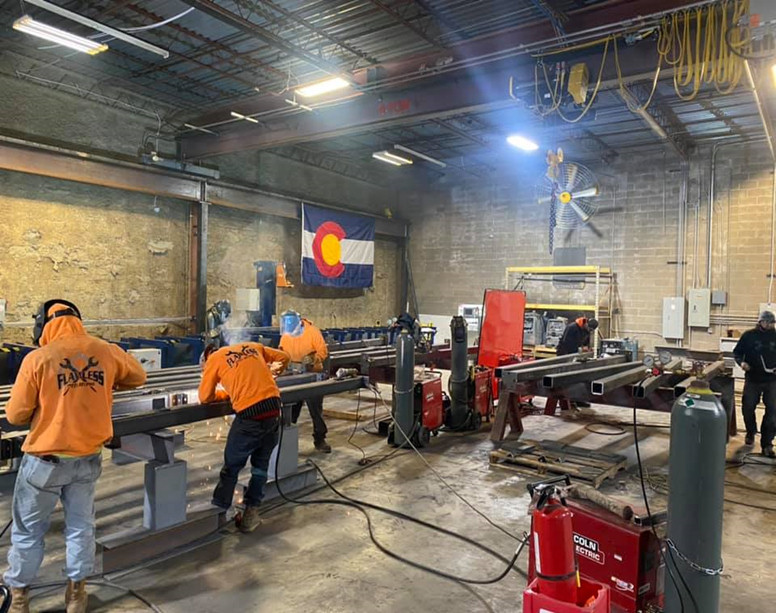Cutting-Edge Metal Fabrication Melbourne: Custom Solutions for Every Task
Cutting-Edge Metal Fabrication Melbourne: Custom Solutions for Every Task
Blog Article
Cutting-edge Patterns in Steel Construction: Enhancing Toughness and Precision
In the world of steel manufacture, the pursuit of sturdiness and accuracy has led to a wave of cutting-edge trends that are reshaping the market. These patterns are not simply shaping the present but also laying the groundwork for the future of steel construction, guaranteeing more enhancements in sturdiness and accuracy.
Advanced Welding Technologies
In the world of steel manufacture, the fostering of cutting-edge welding innovations has substantially reinvented the industry's strategy to attaining premium quality and precision in architectural welds. Advanced welding technologies, such as laser beam welding and friction stir welding, have actually become game-changers in the field. Laser beam welding employs a concentrated laser light beam to sign up with steel components with remarkable accuracy and rate, making it ideal for slim materials and intricate layouts. On the various other hand, rubbing mix welding develops incredibly strong bonds by mechanically intermixing the molecules of the products at the joint, removing the requirement for melting the steel. These modern technologies use various benefits, consisting of lowered heat-affected zones, marginal distortion, and improved mechanical residential properties in the welded joints. By leveraging these advanced welding strategies, steel makers can raise the sturdiness, strength, and accuracy of their structural welds, fulfilling the significantly demanding needs of contemporary construction tasks.
Robotic Automation in Construction
Welcoming robot automation has actually come to be a foundation of modern-day steel manufacture practices, improving and simplifying processes effectiveness across the sector. Robots are transforming the means steel parts are manufactured, supplying unparalleled precision and speed while minimizing human mistake. These automated systems can handle repeated jobs with regular precision, leading to better final result.
One key advantage of robotic automation in steel fabrication is the capability to function around the clock without fatigue, dramatically boosting manufacturing output. This continuous operation minimizes downtime and increases job timelines, eventually saving prices for producers. In addition, robotics can be set to do elaborate tasks that may be difficult or dangerous for human employees, enhancing security in the workplace.
Moreover, robot automation makes it possible for seamless combination with various other digital modern technologies, such as computer-aided design (CAD) software application and Net of Things (IoT) systems (steel fixing). This interconnected technique enhances communication between various phases of manufacture, enhancing operations and ensuring real-time tracking and control. As the steel construction sector continues to advance, robotic automation stands apart as a transformative pressure driving performance and accuracy in making procedures

High-Strength Alloy Advancement
The advancement of high-strength alloy development in steel fabrication is reshaping the market's method to boosting material resilience and performance. High-strength alloys are engineered to exhibit superior mechanical homes, such as enhanced tensile toughness, sturdiness, and deterioration resistance contrasted to typical steel qualities. By including these advanced alloys into fabrication procedures, suppliers can generate components that hold up against greater anxiety levels and severe atmospheres, causing even click for source more resilient and reputable output.
One key benefit of high-strength alloy development is the capacity to minimize material density without endangering architectural stability. This not only causes lighter-weight elements however also adds to cost financial savings and boosted efficiency in fabrication and setting up processes. The improved strength-to-weight ratio of these alloys enables for the design and building and construction of structures with greater load-bearing capabilities while minimizing general weight.
3D Modeling and Simulation Software
Innovations in steel manufacture processes have been considerably driven by the assimilation of cutting-edge 3D modeling and simulation software tools. These tools allow fabricators to produce in-depth online designs of their jobs, allowing them to imagine the last item with accuracy before any type of physical work begins.

Lasting Practices in Steel Production
Incorporating lasting their explanation methods right into steel manufacturing processes is important for decreasing environmental influence and guaranteeing lasting source accessibility. One key sustainable technique is the adoption of energy-efficient innovations to reduce greenhouse gas emissions throughout the steel manufacturing process. This consists of using renewable resource resources, such as solar or wind power, to power steel plants and implementing energy-efficient devices to maximize energy usage.
One more critical aspect of lasting steel manufacturing is the responsible sourcing of raw materials. This entails ensuring that the iron ore and other resources used in steelmaking are obtained from honest and eco-friendly sources. By promoting transparency in the supply chain and sticking to rigorous ecological requirements, steel makers can minimize the unfavorable effects of source removal on local environments and neighborhoods.

Conclusion
To conclude, the cutting-edge trends in steel fabrication such as advanced welding modern technologies, robot automation, high-strength alloy development, 3D modeling and simulation software, and lasting practices are enhancing the durability and accuracy of steel products. These advancements are changing the steel construction industry by boosting sustainability, effectiveness, and quality. It is clear that the future of steel manufacture lies in accepting these advanced modern technologies to satisfy the needs of contemporary building and construction and manufacturing sectors.
In the realm of steel manufacture, the quest of durability and precision has actually led to a wave of innovative fads that are reshaping the market.In the world of steel fabrication, the fostering of cutting-edge welding innovations has significantly revolutionized the market's strategy to achieving remarkable quality and precision in structural welds. As the next page steel construction market proceeds to evolve, robotic automation stands out as a transformative pressure driving efficiency and precision in making processes.
In addition, reusing and recycling steel scrap and waste materials play a considerable duty in boosting the sustainability of steel production. metal fabrication melbourne.In conclusion, the innovative patterns in steel construction such as sophisticated welding innovations, robot automation, high-strength alloy growth, 3D modeling and simulation software program, and lasting practices are enhancing the resilience and accuracy of steel products
Report this page